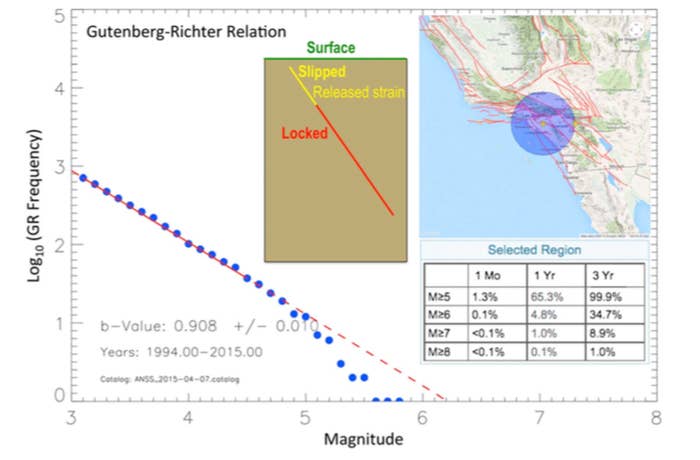
After using GPS and airborne radar to measure stress in tectonic fault lines, NASA scientists have calculated that there is a 99% chance of a 5.0 or greater earthquake hitting Los Angeles within the next two and a half years.
An earthquake that size is considered moderate, but depending on where it struck, the shaking could cause millions in damage to buildings and infrastructure, and even kill.
The paper, written by scientists at the Jet Propulsion Laboratory in Pasadena, California, and published in Earth and Space Science, examined the Orange County town of La Habra, where a 5.1-magnitude quake in 2014 caused about $12 million damage. A 6.1 quake near Napa, California, in 2015 left one person dead, as many as 200 injured, and caused an estimated $300 million in damage.
According to the authors, changes on the surface of the earth can help predict what's going on with faults below its surface. Looking before and after the 2014 La Habra earthquake, the researchers found most of the deformation was shallow — suggesting deeper pressure remained to be released.
"The unreleased strain accumulation is equivalent to a [magnitude] 6.1-6.3 earthquake," lead author Andrea Donnellan told BuzzFeed News. "We put no time on that estimate."
The authors also found a magnitude 5.0 earthquake was "missing" for the region, based on a seismic analysis. Together, their findings suggested a moderate — or larger — earthquake would take place somewhere within the L.A. region's intricate fault system soon.
The paper sparked concern among Southern California residents, as well as a skeptical response from the U.S. Geological Survey, which noted that the NASA paper fails to explain how the 99% probability was calculated.

The USGS' own seismic hazard map puts the probability of an earthquake in the same region within three years to be 85%.
The USGS' 85% probability was the result of input from hundreds of scientists working toward a consensus using multiple models, said Lucy Jones, a USGS seismologist. The USGS hazard assessment is then used by government agencies in their emergency planning.
"It's a way to try and incorporate a range of scientific understanding and get the best assessment," she told BuzzFeed News.
The probability of 85% means a 5.0 earthquake every few years, Jones explained. Some of them could cause damage, while others might be barely felt by most Southern California residents.
A probability of 99.9%, however, would suggest a 5.0 earthquake every few months, a rate that doesn't fit with historical observations, Jones said.
Actually, the NASA paper found only a 1.3% probability on an earthquake in a 1-month span, said John Rundle, a UC Davis professor who was one of its authors. The difference comes from the fact that USGS forecasts earthquakes independent of time, while the NASA paper used a model that considers time, he wrote in a blog post.
According to a USGS statement, the earthquake rate implied by the 99.9% probability is "significantly higher than observed at any time previously in Southern California."
The lack of details on the method of analysis by the NASA scientists, the USGS added, "makes a critical assessment of this approach very difficult" and does not change its earlier finding of an 85% probability.
Simply put, it's true that California regularly sees earthquakes, Jones said, but one paper shouldn't cause panic.
"We have a lot of earthquakes, and we need to prepare for them," she said.
The techniques pioneered by NASA can provide more information for forecasters to draw from, Donnellan said. GPS is already being used by the USGS, and Donnellan said she expects radar — like that used in her paper — will also be adopted.
She agreed that for residents, the most important thing is to be prepared.
"California residents should remember that we live in earthquake country and that it is important to be prepared," she said.
